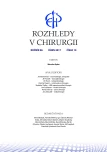Characterisation of Candida sp. isolated from patients after abdominal surgery
Authors:
V. Adámková 1,2; A. Vaňková 1; J. Ulrych 3; K. Matek 3
Authors‘ workplace:
Ústav lékařské biochemie a laboratorní diagnostiky VFN, Praha
přednosta: prof. MUDr. T. Zima, DrSc., MBA
1; Ústav lékařské mikrobiologie LF Univerzity Palackého, Olomouc
přednosta: prof. MUDr. M. Kolář, PhD.
2; Chirurgická klinika VFN, Praha
přednosta: prof. MUDr. Z. Krška, DrSc.
3
Published in:
Rozhl. Chir., 2017, roč. 96, č. 10, s. 426-431.
Category:
Original articles
Overview
Introduction:
Intraabdominal candidiasis (IAC) is the predominant type of invasive candidiasis after candidemia. The majority of epidemiological studies on Candida are focused only on bloodstream infections. Nevertheless, the role of blood cultures has limited application in patients with abdominal candidiasis. IAC, which includes peritonitis and intraabdominal abscesses, may occur in around 40% of patients following repeat gastrointestinal (GI) surgery or GI perforation.
Method:
Retrospective analysis of culture isolates of Candida sp. from clinical specimens of patients after abdominal surgery. The study period was from January 1 to October 31, 2016.
Results:
Our study of 33 patients with findings of Candida sp. from the abdominal cavity found a mortality of 15.2%, the most frequent strain being C. albicans and C. glabrata. All strains of Candida sp. were susceptible to echinocandins.
Conclusions:
Candida sp. is part of normal microbiota of the gastrointestinal tract and its isolation is often difficult to interpret. Unfortunately, the pathophysiologic importance of Candida isolation from the abdominal space is not completely clear in many clinical situations.
Key words:
invasive candidiasis − intra-abdominal candidiasis − laboratory diagnostics
Sources
1. Wallace WC, Cinat ME, Nastanski F, et al. New epidemiology for postoperative nosocomial infections. Am Surg 2000;66:874−8.
2. Bassetti M, Marchetti M, Chakrabarti A, et al. A research agenda on the management of intra-abdominal candidiasis: results from a consensus of multinational experts. Intensive Care Med 2013;39:2092–106.
3. Vergidis P, Clancy CJ, Shields RK, et al. Intra-abdominal candidiasis: The importance of early source control and antifungal treatment. PLoS One 2016. Available from: https://doi.org/10.1371/journal.pone. 0117195.
4. Menichetti F, Sganga G. Definition and classification of intra-abdominal infections. J Chemother 2009;Suppl 1:3−4.
5. Leroy O, Gangneux JP, Montravers P, et al. Epidemiology, management, and risk factors for death of invasive Candida infections in critical care: a multicenter, prospective, observational study in France (2005–2006). Crit Care Med 2009;37:1612–8.
6. Vincent JL, Rello J, Marshall J, et al. International study of the prevalence and outcomes of infection in intensive care units. JAMA 2009;302:2323–9.
7. Schelenz S. Management of candidiasis in the intensive care unit. J Antimicrob Chemother 2008;61,Suppl 1:i31–4.
8. Montravers P, Leroy O, Eckmann C. Intra-abdominal candidiasis: it still a long way to get unquestionable data. Intensive Care Med 2015;41:1682–4.
9. Sandven P, Qvist H, Skovlund E, et al. Significance of Candida recovered from intraoperative specimens in patients with intra-abdominal perforations. Crit Care Med 2002;30:541–7.
10. Dupont H, Paugam-Burtz C, Muller- Serieys C, et al. Predictive factors of mortality due to polymicrobial peritonitis with Candida isolation in peritoneal fluid in critically ill patients. Arch Surg 2002;137:1341–6.
11. Montravers P, Dupont H, Gauzit R, et al. Candida as a risk factor for mortality in peritonitis. Crit Care Med 2006;34:646–52.
12. Kett DH, Azoulay E, Echeverria PM, et al. Candida blood- stream infections in intensive care units: analysis of the extended prevalence of infection in intensive care unit study. Crit Care Med 2011;39:665–70.
13. de Ruiter J, Weel J, Manusama E, et al. The epidemiology of intra-abdominal flora in critically ill patients with secondary and tertiary abdominal sepsis. Infection 2009;37:522–7.
14. Khan ZU, Chandy R, Metwali KE. Candida albicans strain carriage in patients and nursing staff of an intensive care unit: a study of morphotypes and resistotypes. Mycoses 2003;46:479–86.
15. van de Veerdonk FL, Kullberg BJ, Netea MG. Pathogenesis of invasive candidiasis. Curr Opin Crit Care 2010;16:453–59.
16. Garey KW, Rege M, Pai MP, et al. Time to initiation of fluconazole therapy impacts mortality in patients with candidemia: a multi-institutional study. Clin Infect Dis 2006;43:25–31.
17. Eggimann P, Bille J, Marchetti O. Diagnosis of invasive candidiasis in the ICU. Ann Intensive Care 2011;1:37.
18. Cornely OA, Bassetti M, Calandra T, et al. ESCMID guideline for the diagnosis and management of Candida diseases 2012: non-neutropenic adult patients. Clin Microbiol Infect 2012;18,Suppl 7:19–37.
19. Eggimann P, Garbino J, Pittet D. Epidemiology of Candida species infections in critically ill non-immunosuppressed patients. Lancet Infect Dis 2003;3:685–702.
20. Pittet D, Monod M, Suter PM, et al. Candida colonization and subsequent infections in critically ill surgical patients. Ann Surg 1994;220:751–8.
21. Leon C, Ruiz-Santana S, Saavedra P, et al. Usefulness of the “Candida score” for discriminating between Candida colonization and invasive candidiasis in non-neutropenic critically ill patients: a prospective multicenter study. Crit Care Med 2009;37:1624–33.
22. Bassetti M, Righi E, Ansaldi F, et al. A multicenter multinational study of abdominal candidiasis: epidemiology, outcomes and predictors of mortality. Intensive Care Med. 2015;41:1601–10.
23. Tissot F, Lamoth F, Hauser PM, et al. Beta- glucan antigenemia anticipates diagnosis of blood culture-negative intraabdominal candidiasis. Am J Respir Crit Care Med 2013;188:1100–9.
24. Leon C, Ruiz-Santana S, Saavedra P, et al. Value of beta-D- glucan and Candida albicans germ tube antibody for discriminating between Candida colonization and invasive candidiasis in patients with severe abdominal conditions. Intensive Care Med 2012;38:1315–25.
25. Eckmann C, Sanchez-Garcia M. Monitoring treatment response in abdominal sepsis with procalcitonin–if only! Crit Care 2013;17:1017.
25. Gürlich R, Adámková V, Ulrych J, et al. Základní principy diagnostiky a léčby sekundární peritonitidy – doporučení odborníků s podporou SIS. Rozh Chir 2014;93:334−52.
Labels
Surgery Orthopaedics Trauma surgeryArticle was published in
Perspectives in Surgery

2017 Issue 10
Most read in this issue
- Complicated intraabdominal infections in surgical patients–empiric antimicrobial therapy management
- Clostridium difficile remains a medical challenge
- Bleeding during anticoagulant and antiaggregation therapy as a cause of acute abdomen
- Treatment of locally advanced rectal cancer – is it time for a change?
